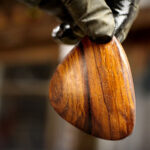Unlike varnish and paint, which lie on the surface, wood-finishing oil penetrates deeply into the pores, forming a resilient finish that will not crack, peel or chip. Most oil finishes require no more than annual maintenance to preserve their appearance.
Types of Oil Finish
Some woodworkers consider oil finishes suitable only for hardwoods, but oil makes a handsome finish for any timber, especially pine, which turns a rich golden color when oiled.
Linseed oil – Traditional linseed oil is rarely used nowadays for finishing wood, mainly because it can take as long as three days to dry. But modern manufacturers have been able to reduce drying time to about 24 hours by heating the oil to produce boiled linseed oil.
Tung oil – A tung oil finish, which is resistant to water, alcohol and acidic fruit juice, takes about 24 hours to dry and is suitable for both interior and exterior woodwork.
Finishing oils – Commercial wood-finishing oils, which are based on tung oil, include synthetic resins to improve durability. Depending on temperature and humidity, finishing oils dry in about six hours. Often referred to as teak oil or Danish oil, finishing oils are suitable for any environment and can also be used as sealer coat for oil varnish or paint.
Non-toxic oils – Although pure tung oil is non-toxic, some manufacturers add metallic driers to it – so don’t use tung oil for items that will come into contact with food, unless the maker’s recommendations specifically state that it is safe to do so. Alternatively, use ordinary olive oil or one of the special salad bowl oils sold for finishing food receptacles and chopping boards.
Gelled oil – A blend of natural oils and synthetic resin is available as a thick gel that behaves more like a soft wax polish. It is packed in tubs so the gel can be picked up on a cloth pad. Gelled oil can be applied to bare wood and, unlike other oil finishes, can also be applied over existing finishes such as varnish and lacquer.
Oiling Bare Wood
Since oil is a penetrating finish, oils other than gelled oil cannot be applied to a pre-varnished or lacquered work piece. When finishing previously oiled timber, use white spirit to clean old wax from the surface.
Applying oil – Apply the first coat of oil using a fairly wide paintbrush to wet the surface thoroughly. Leave it for about 10 to 15 minutes to soak in, then ensure that coverage is even by wiping excess oil from the surface with a soft cloth pad.
After six hours, use an abrasive nylon-fiber pad to rub oil onto the wood in the general direction of the grain. Wipe excess oil from the surface with a paper towel or cloth pad, then leave to dry overnight. Apply a third coat in the same way.
Allow the last coat to dry thoroughly, then burnish the surface with a duster to raise a soft sheen. For a smooth satin finish, dress interior woodwork with wax polish, using a clean abrasive nylon pad or fine steel wool.
Oiling turned pieces – After sanding a turned workpiece, switch off the lathe before you brush oil onto the wood. Let it soak in for a short while, then, after wiping off excess oil with a rag, restart the lathe and burnish by holding a soft cloth pad against the slowly rotating workpiece.



